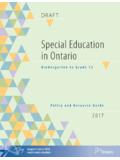Transcription of Summarized Budget View Overview and Glossary
1 1 Summarized Budget view Overview and Glossary The Summarized Budget view is a summary of each school s Budget as it appears in Galaxy, the school-based budgeting system used by all New York City Public Schools. These reports were especially designed to provide a timely, simpler and more meaningful view of each school s Budget . It contains Summarized data that highlights the most important aspects of a school s Budget , for example, budgets for teachers are presented by grade and subject. Making school budgets available to the public in this format is another important step in the Department s effort to create transparency, begun with the School Based Expenditure Reports and continued with the availability of school allocation data on the DOE website.
2 This document contains a Glossary of terms used in the report, as well as a brief explanation of the Budget process and organization of the report to assist you in understanding both the source and content. I. What is Galaxy and what is the Table of Organization? Galaxy is the school based budgeting system used by all New York City public schools, as well as the Field Support Centers (FSC). Galaxy presents a school s Budget as a Table of Organization (TO), very much like the Organization sheets that schools used to list all of their staff. In Galaxy, the terms Table of Organization or its abbreviation TO are synonymous with the term Budget .
3 The TO contains all the people working in the school and their associated Budget amounts, as well as the amounts budgeted for non-full time personnel items such as per session (hourly) costs, per diem (daily) costs, and OTPS (Other than Personal Services, , supplies, equipment, books, etc). All funds allocated to schools and scheduled by schools are reflected in the Galaxy TO. II. How does a school s Budget get created and who enters it? Planning for the following year begins in the late winter/early spring with register projections, meetings with FSC staff and input from the School Leadership Team.
4 The outcome of this process is the school s Comprehensive Education Plan (CEP) for the coming year. In the spring, schools receive the majority of their Budget allocations for the coming year via Galaxy from the central School Budget Office. Additional allocations are made throughout the summer and continue into the school year. Some allocations are made to schools by the FSCs in consultation with local instructional staff to address specific student-based needs. 2 As soon as allocations are made, the school begins the work of creating their Budget for the new school year. This process involves associating all line items on a school s Table of Organization with the new allocations consistent with their CEP, funding guidelines associated with each allocation, and local and system-wide instructional initiatives.
5 All Budget entries are submitted by the principal or their authorized designee, and approved by the FSC supporting the school. Community Superintendents also approve initial budgets at the school level. III. What are the Sections on the Summarized view ? The Summarized Budget view , like Galaxy, presents the school s Budget , or Table of Organization, in Sections. This is similar to how paper organization sheets are set up. At the top of the report are the Leadership, Coordinator/Supervisor/Dean, and School Secretary sections. These are followed by the Teacher sections (see more below), and other types of staff such as Guidance Counselors, School Aides, Paraprofessionals, etc.
6 There is also a Professional Development (PD) section which includes any full time PD staff, including Coaches. Towards the bottom of the report are Per Session, Per Diem, and OTPS. The last section of the report, People Working Partial Year, displays the partial year costs associated with staff no longer working in the school. Teachers are displayed in sections depending on the instructional level of the school. All teacher sections display a subject, with the exception of Elementary Classroom Teachers which is displayed by grade, as noted. Teachers who provide direct services to students other than special needs services are in one of the following sections: Elementary Schools: Classroom Teacher (This section shows only grade, not subject.)
7 Elementary Cluster/Quota (Please note: this section contains teachers who provide mandated coverage PLUS other non-homeroom subject area teachers above and beyond required cluster positions.) Classroom Teacher Standard Assessment (Citywide Special Education) Classroom Teacher Alternate Assessment (Citywide Special Education) Middle Schools with homerooms: Homeroom Teacher Cluster/Quota (See note above on Elementary Cluster/Quota.) Homeroom Teacher Standard Assessment (Citywide Special Education) Homeroom Teacher Alternate Assessment (Citywide Special Education) Middle Schools without homerooms: 3 Cluster/Quota (This section contains all subject area teachers.)
8 High Schools: High School Departments This section contains all subject area teachers K-12, K-8, and 6-12 Schools: Multi-level schools have a combination of the teacher sections cited above to accommodate their particular structure. Citywide Special Education Schools: The following teacher sections appear on select Citywide Special Education Tables of Organization as appropriate: Teacher Home Instruction Teacher Hospital Instruction Audiologists Teacher Hearing Teacher Vision Special Needs: This section contains teachers providing services to students with both mandated special education services and students receiving academic intervention services in general education.
9 Speech Teachers, Crisis Intervention Teachers and Intervention/Prevention teachers are included here. Other Sections on the TO: Leadership: This section includes Principals, Assistant Principals, Interns and Interim Acting staff. Coordinators/Supervisors/Deans: This section includes supervisors, deans, program coordinators, and parent coordinators. School Secretary: This section includes full time or permanent part time (F status) school secretaries. SAPIS: This section includes Substance Abuse Prevention/Intervention Service workers. These employees are now budgeted in a district location, not in schools.
10 Guidance Counselors/Social Workers: This section includes guidance counselors providing both mandated and non-mandated services. 4 SBST (School Based Support Team, also known as the IEP Team ): This section includes Psychologists, Social Workers and Guidance Counselors who perform evaluations for special education services, and support personnel such as family workers (DC37 paraprofessionals) and clerical staff. Paraprofessionals: This section includes UFT educational paraprofessionals who work in the classroom in both general and special education classes. School Aides and Other Support Staff: This section includes all school aides, lab specialists and assistants, school business managers, clerical staff (excluding school secretaries), neighborhood workers, computer technicians.








